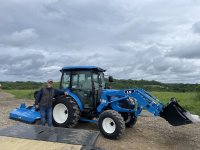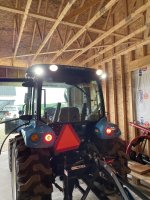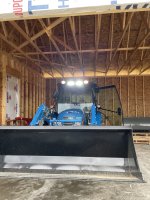Yup, there’s no doubt there will always be folks around who just flat out don’t like it outside and are afraid of getting stung by a bee. A cab is surely the best way to go for them.So, as I've said before; I tend to argue both sides of an argument. About 12-15 years ago, I was actively going to auctions, looking for a used tracked skid steer. At the time I was doing some weekend side work, doing driveways, minor grading/minor clearing, but renting machinery for the jobs, and not really making much true profit.
Anyways, at the start of the search, I wanted Nothing to do with glass cab on a machine, as I frankly prefer to not have it on construction equipment. Anyway, had someone tell me; for the few thousand dollars more for the cab; if you decide to not rain out even 3 or 4 days over the Life of the machine because of the cab, it's paid for itself. The world ended in 2007/2008, and I ended up not buying the skid steer; but I do keep that in mind.
I still prefer the situational awareness of an open machine, the easier communication (if you work around others), the better visibility, and the faster/easier dismount/remount, But cabs 100% have a place, and are the right answer for some people/situations.
You are using an out of date browser. It may not display this or other websites correctly.
You should upgrade or use an alternative browser.
You should upgrade or use an alternative browser.
Tractor decision
- Thread starter New property
- Start date
- Views: 41761
-
- Tags
- tractor decision
More options
Who Replied?
/ Tractor decision
#181
paulsharvey
Super Member
Another aspect of cabs is safety. I once spend several months, 10-12 hrs/day, 6 days/week, on an open broom tractor, sweeping parking lots/roads, with a dry, non adjustable angle broom. That honestly probably took a few years off my life expectancy... As much as a cab can be in the way in the woods, if a tree or 6"+ limb falls on the machine; yes, you'll 100% mess up an expensive machine; but even a 500# limb falling from just 20 ft in the air can be deadly or worse on a 100% open machine. 99% of open station tractors are just that; open station; where a open station front end loader, mini hoe, back hoe, dozer, whatever, will have a ROPS, and cover, that is rated to protect from over head hazards, offer more protection than a simple 2 post ROPs on a tractor, in a roller over, ect.
arrow
Super Member
To give you an example, My machine has two priorities: logging and snow plowing. It is large enough where I can wait out a storm with even a 30" dump and plow when the winter sun is out. When logging, I jump on and off my tractor about 50 times hooking stems up, readjusting chain and choker tension, getting to the landing and unhooking the hitch, getting back on for the next turn and rinse and repeat. My woods are dense here and I would hazard that a cab would have had broken something in the 10 yrs I've had this one.
A cab for me is a headache. I work at a tractor place and I disdain when having to get into a cab tractor to move or use it at work. But that's me.
So it comes down to personal usage and to denigrate either set up is simply a generalization that may not fit your usage whatsoever.
If I lived in Florida with heat, bugs and such, I probably would lean toward a cab.
To each his own has never been truer.
A cab for me is a headache. I work at a tractor place and I disdain when having to get into a cab tractor to move or use it at work. But that's me.
So it comes down to personal usage and to denigrate either set up is simply a generalization that may not fit your usage whatsoever.
If I lived in Florida with heat, bugs and such, I probably would lean toward a cab.
To each his own has never been truer.
nybirdman
Super Member
Right now is snowing and blowing,not regretting snow plowing in the least.
Cabs have their place.I have only broken off a couple of cab lights in ten years.
My son has an open station ,gear drive and wouldn't have anything else.Each their own.
Cabs have their place.I have only broken off a couple of cab lights in ten years.
My son has an open station ,gear drive and wouldn't have anything else.Each their own.
Slowpoke Slim
Elite Member
- Joined
- Jan 6, 2017
- Messages
- 3,918
- Location
- Bismarck, ND
- Tractor
- Husqvarna YTH24V48 riding mower, Branson 3725CH
You're just adorable.Yup, there’s no doubt there will always be folks around who just flat out don’t like it outside and are afraid of getting stung by a bee. A cab is surely the best way to go for them.
New property
Member
Thank you that was informative35-45 hp tractor is probably the sweet spot. Frame size also matters. The best way to experience this is at the John Deere Dealer
3046R - Mid frame - 45.3 hp - 4,008 lbs (cab) - 11.2-24 R1 Rear Tires
4044R - Large Frame - 43.1 hp - 4,675lbs (cab) - 13.6-28 R1 Rear Tires
You are new to this, so test drive a lot of tractors. You will learn something new each time. Use the John Deere models above as a learning experience. How do you like the size and feel of each tractor and cab? The 3046R has more horsepower, but the 4044R will put a LOT more power to the ground because of its taller tires and extra weight. Either would work well for you (personally, I am a bigger is better guy)
Once you have decided on the frame size you prefer - go do lots more test drives, and you will keep getting a better idea what matters to you.
I prefer R1s (ag tires) for the traction,but R14s seem to be a good option. R4s (industrial tires) look sexy but turn into racing slicks in wet snow and mud.
Make sure you learn the difference between traditional (turnbuckle/fixed ends) 3 point hitches and premium 3 point hitches (telescoping links and extendable ends). They are waaaaay easier to hook up implements. I would never go back to the old way.
Finally, if there is a Kioti Dealer near you, I would give them a look.
New property
Member
Agoraphobic & apiphobic. You are a tractorphobic due to the cab.Yup, there’s no doubt there will always be folks around who just flat out don’t like it outside and are afraid of getting stung by a bee. A cab is surely the best way to go for them.
finn1
Platinum Member
- Joined
- May 10, 2009
- Messages
- 899
- Location
- Upper Michigan, Marana Az.
- Tractor
- Kioti CK4010 hst, Cab, Deere 26G excavator, K1500 w/ Boss 7’6” plow, F450 dump W/ Boss 10’ straight blade Super Duty plow, F250 reg cab, F350 cc drw, Case TR310 CTL
I’m fairly certain the “Cummins” engines in the TYM tractors are actually A series engines, which were originally designed and produced by Onan in the late seventies.No treadle, 2 pedals like mostly everyone else.
They built the 3 and 4 cylinder diesels for Cummins for many years, now they are putting them in the tractors. Old school, proven engines, coupled with Bosch mechanical pump thats in million other small diesels. No electronics, you can take the DEF out and engine will not know its missing.
TYM just started building tractors for Yanmar...
Cummins eventually bought Onan, probably in the late 80s or 90s, and integrated them into their generator business.
The A series engines were considered light duty engines, and had nothing in common with the B series Cummins engine everyone knows. For one, the A series is indirect injection vs the more modern Direct Injection the B series has.
The A series is a low cost entry level Diesel. That doesn’t make it bad, but it’s no ISX.
New property
Member
Update. Took delivery today on LSMT347hc.Hi, I’m new to this forum. I have 50 acres, 15 pasture, 35 wooded. We are starting construction on a new home, 1400 foot driveway. Right now I am focused on LS
MT347 cab hydro with bucket, plow, box blade, brush hog. Am I on the right track? Up until now I have only had garden tractors. Thnx, Barry
Added 2 LEDs frt and 2 LEDs rear. Hooks and drings welded on bucket.



